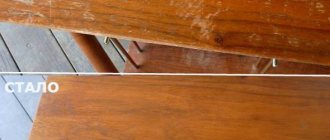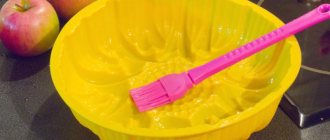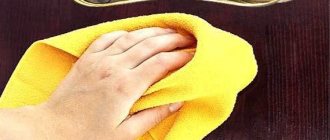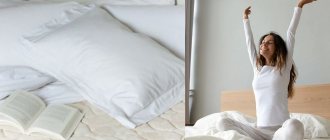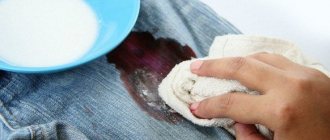Removing coffee and tea stains
Fresh stains from popular drinks can be removed without much difficulty. Sometimes wiping the wood with plain water or a soap solution or dishwashing detergent is enough.
A couple of minutes after soaping, wipe the item dry with a clean cloth. Stubborn stains are removed with a weak solution of ammonia or ethyl alcohol. Be sure to move the sponge along the visible wood fibers so as not to damage them.
General rules for furniture care
The easiest way to care for furniture is to clean it from dust. Dust is always present in the house, covering all pieces of furniture.
It is necessary to wash furniture from dust with a damp or dry cloth.
How to care for furniture if it has a varnished surface? Lacquered furniture should be washed with a damp cloth with an antistatic agent, then wiped dry.
How to Remove Alcohol, Juice or Sugary Drink Stains
Stains from sweet liquids can be removed with strong coffee. Moisten a cloth with the drink, wipe off the dirty mark, and then wash the area with soap, dry and polish with linseed oil.
Wine stains can be easily removed with 3% hydrogen peroxide or 3% ammonia. Stubborn marks will have to be cleaned off with fine-grain sandpaper, but not in a circular motion, but along the grain. Next, the base is washed and also treated with linseed oil.
Vinegar solution
This method is more effective than cleaning with soapy water, but not as effective as washing with solvent. But vinegar can be used on painted surfaces. But before that, be sure to check the product on the back of the product.
How to wash wood:
- Mix about 1 part white distilled vinegar with 16 parts water in a bucket or other container.
- Dip the fabric into the solution and wring it out until it is barely damp.
- Wipe the entire surface using circular motions and light pressure. If the rag becomes noticeably dirty, rinse it in plain water until it becomes clean again. Then soak it again in the vinegar solution and use it for its intended purpose.
- Repeat the process until you have cleaned the entire surface of the wood. If there are any cracks or decorative carved areas, for example, you can use a toothbrush dipped in the solution to clean the inside.
Polish the washed product with a clean and dry cloth. Make sure that there are no wet areas left anywhere, otherwise the wood may become deformed and deteriorate. If your wood piece still looks dirty after using several cleaning methods, consider refinishing it.
Found a violation? Report content
How to remove dish marks
Hot glasses and plates often leave unsightly marks on wood. They are rubbed with a mixture of linseed oil and table salt in a 1:1 ratio.
The resulting paste is applied to the whitened circle, left for an hour, then polished with a soft cloth. Instead of a rag, you can take a wine cork - it also polishes wood perfectly.
Another option is to combine an abrasive substance (soot from burnt paper, crushed activated carbon) with any greasy product and thoroughly wipe the base with this mixture, then immediately wash thoroughly.
Features of a wooden kitchen
A significant advantage of a wooden kitchen is its resistance to high temperature and humidity.
And one of the unpleasant disadvantages is the poor quality of processing of wooden parts. It is often the reason for the fragility of kitchen furniture. Different types of wood may have characteristic properties, for example:
- pine wood has good strength;
- oak is less susceptible to rotting;
- beech is almost as hard as oak, but less moisture resistant;
- clear - durable;
- linden is resistant to moisture.
So how to clean grease from a wooden kitchen? Today there are a wide variety of types of wooden kitchen furniture on the market. They differ from each other not only in the type of wood from which it is made, but also in the type of processing of wooden surfaces. This is why there is a wide variety of ways to clean wooden furniture.
Kitchens that are painted with enamel, stain, or kitchens treated with wax or oil should be cleaned with products with neutral acidity.
The following treatments are contraindicated for such furniture:
Hydrogen peroxide
Ammonia solution
Lemon acid
Alcohol solution
Traces of wax and paraffin
There are several ways to get rid of wax or paraffin on a wooden surface:
- Leave the wax until completely cured. Then rub liquid soap into it and clean with a cloth.
- Dissolve wax and paraffin with table vinegar diluted with water. As it dries, treat the base with oil.
- Place several ice cubes wrapped in cellophane on the wax stain. When the wax cools and becomes brittle, remove it with a knife blade and wipe the surface with a solution of apple cider vinegar and water (1:10).
- Dip the knife in boiling water for 20 seconds, then remove the wax drop and wipe the surface with a rag soaked in gasoline.
- Warm the wax with a hairdryer and remove the residue with a soft cloth.
Cleaning with solvent
The solvent does an excellent job of removing stains and dirt that dishwashing detergent cannot remove. But keep in mind that this method cannot be used on painted wood, otherwise you will remove the paint. Also, be sure to check to see if solvent will ruin the finish. To do this, apply a little product to an inconspicuous area. If there are no stains or stains, then start cleaning.
Lost weight: what Sofia Tarasova sacrificed for the sake of “VIA Gra” (new photos)
"Dad is offended." Agata Muceniece about her relationship with Priluchny after the divorce
A Brazilian travels 36 km by bike every day to take his loved one home.
It is advisable to carry out the procedure itself outdoors or in a well-ventilated area. Otherwise, you can be poisoned by toxic fumes. How to clean wood:
- Dampen a clean cloth with solvent.
- Wipe the entire wooden surface with it. If necessary, lightly scrub the wood to remove stubborn dirt or stains. If you need to get to hard-to-reach places, use an old toothbrush soaked in solvent.
- Wipe off any remaining product with a slightly damp cloth. If after this the wood is a little wet to the touch, then wipe it with an additional dry microfiber.
Water stains
Sometimes unsightly water stains remain on the wood. They can be removed using different methods.
Important! When removing stains, you must act carefully so as not to damage the base.
How to Remove White Water Stains on Wood
Small water stains can be easily wiped off with a regular rubber band. If this method does not work, choose any other from the list:
- Soak a cotton swab in vegetable oil and wipe the wooden product.
- Mix cigarette ash and oil. Gently rub into the white mark on the wood.
- Rub the wood with oil, cover the area with flour, and leave for an hour. Afterwards, thoroughly rinse the contaminated area.
- Cover the stain with a cotton cloth and gently run a not too hot iron (without steam) over it for a few seconds.
How to Remove Dark Water Stains on Wood
Such stains are quite difficult to remove from wood. It is better to purchase gentle household bleach, dilute it strongly with water (about half), and apply it to the stain with a soft sponge. After the surface has dried, thoroughly wipe the base and treat with oil.
What should you consider?
Any problem is solved taking into account the type of board, its coating and the type of contamination.
The parquet floor should not be wetted with water, otherwise it will quickly become unusable.
Excessive moisture is unacceptable , even if the boards are varnished, since the parquet floor is laid from equally small boards. They are tightly fitted one to another. This cladding on a concrete or wood base has many joints that trap water and eventually destroy the wood.
The “For Parquet” product will provide high-quality cleaning and will not damage the expensive wooden flooring.
The products are also selected specifically for parquet. They form a shiny protective film, polish the boards and close cracks.
Varnished plank floors also require a special approach to cleaning.
And the boardwalk is made from large boards. Their sizes are different. And in order to clean the plank floor, its own nuances are taken into account. Namely, whether it is painted or not. Therefore, caring for wood flooring also depends on its treatment:
All joints can be cleaned with a regular vacuum cleaner with a floor attachment.
- First you need to vacuum the floor , that is, use dry washing. This applies to all wood flooring. After all, it is very difficult to wash out dust in cracks and joints, even using the most effective cleaning agent;
- Then wet cleaning of the wood floor begins.
Renewing old darkened wood
In recent years, the trend of not only building new wooden houses, but also restoring houses and already battered buildings has become increasingly popular.
It's no secret that over time, wood loses its pristine beauty: the golden, warm color of this natural material fades and darkens within a few years. And constant exposure to precipitation, temperature changes and other factors lead to the formation of mold and mildew. How to restore old, darkened wood, returning it to its former attractive appearance? There are currently several different ways to solve this problem.
Some people prefer to use radical methods, such as siding or facing a wooden structure with bricks. But such options do not initially imply the preservation of WOOD, so we will not dwell on them in detail. Let's consider only those methods that allow you to restore, renew and refresh damaged wood, and not hide it “out of sight”:
| Recovery methods | Advantages | Flaws | Result |
| 1. Grinding is a mechanical method that allows you to remove existing biological damage and remove the top darkened layer of wood |
|
| The wood will look completely new and fresh, but we must not forget about the need for its MANDATORY further treatment with bioprotective and antiseptic compounds. Otherwise, the result will be very short-lived. |
| 2. Coloring - usually with inexpensive enamels or paints |
|
| A building treated in this way will look refreshed and updated for some time, but, unfortunately, it will no longer look very wooden. And non-breathable coatings that form cheap paints and enamels will lead to the destruction of wood from the inside. |
| 3. Wood bleaching – the most popular currently are chlorine bleaching compounds. |
|
| As in the first case, we will get practically new wood with a fresh and light color. But there is still a lot of work ahead - bioprotective treatment and, if desired, giving the wood the desired color. |
| 4. Use of a restorative composition - for example, Aquatex Restorer |
|
| The result is impressive. After applying just two layers of the composition, we get not just renewed wood, but a durable coating of the desired color, providing bioprotection and strengthening the aged wood. |
There can be no consensus on the best way to renew wood that has darkened over time. Radical measures are necessary only in extreme cases; most often the problem can be solved with minimal effort. When choosing a method that is optimal, remember that we are talking about your home and the comfort in it. Excessive savings are hardly appropriate here. It is worth taking into account all the circumstances and giving preference to the most effective means that will allow you to restore wood efficiently and quickly.
| Old, unpainted house | House coated with Aquatex Restorer |
Of course, all of the listed methods of wood renewal are quite viable and have a right to exist. But now it can be argued that the use of a restoration composition, such as Aquatex Restorer, is exactly the way through which we get the desired result with minimal effort.
Prevention
To prevent the lining from turning black and deforming, it is enough to follow a few simple recommendations:
- if the façade of a building is covered with wooden clapboard, then it must be mounted at a short distance from the surface to be refinished,
- after covering a wall, floor or ceiling with special boards, the building material must be processed (primed, varnished, painted, etc.),
- in a room lined with clapboard, you need to equip a good ventilation system,
- if it is not possible to install fans, ventilate the room regularly,
- Once every six months, the cladding board must be impregnated with a special protective compound, which minimizes the risk of mold and mildew and protects the building material from precipitation.
And lastly: the higher quality materials are used for interior or exterior decoration, the less time and effort will be needed in the future to return the cladding board to its original appearance.





